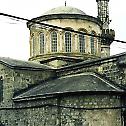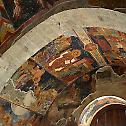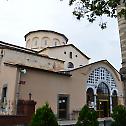Most of the temples that were built in Pontus, have become mosques today
Today, like in the last two millennia, temples are being built to glorify the Creator, but also to alleviate the pain of our hearts as Christians, seeking even a small understanding of life through the Holy Spirit. Temples were once built in Pontus, where prayers, Divine Liturgies, baptisms and funeral services were held. As history would have it, the Greek ancestors were expelled.
Most churches became mosques. It is the same story as with the Hagia Sophia in Constantinople.
Church of Hagia Sofia
Hagia Sophia of Trebizond is a church with a prominent position both between the monuments of Trebizond and Pontus and among the Byzantine monuments in general. It is a monument intertwined since its foundation with the local imperial dynasty of the Megas Komnenos family.
The Church of Hagia Sophia is located on the beach of the city, west of the fortress of the Megas Komnenos famliy, and is estimated to have been built around 1250 by the Emperor of Trebizond Manuel I Megas Komnenos. The Church of Hagia Sophia of Trebizond was an important monument of architecture, sculpture and painting. Next to the temple there was a homonymous monastery, which was used for the burial of the laity. The temple and the monastery were dedicated to “Sophia”, the Wisdom or the Word of God, that is, to Jesus Christ, and therefore the monastery was also called the Monastery of Our Lord Jesus Christ, and was celebrating on August 6.
It was converted into a mosque around in the middle of the 16th century and during the First World War it was used as a warehouse, but also as a temporary hospital.
Divided into two
Hagia Sophia had been operating as a museum since 1961. More recently, in July 2013, the jurisdiction of the church was transferred by a court decision from the Ministry of Tourism to the General Directorate of Vakoufia, which in turn decided to reopen it as a mosque, after about half a century. Thus, today the temple is divided into two. The main church has been converted into a mosque, where the dome and the altar have been covered, while the aisles of the church function as a museum, where one can see the hagiographies.
However, the Chamber of Architects of Trebizond demands Hagia Sophia to function only as a museum and not as a mosque, and visitors to be able to see the hagiographies and the rest masterpieces of Orthodox ecclesiastical art.
The Regional Administrative Court of Samsun (Amisos) has approved the request and it now remains to implement the decision.
Church of Saint Eugenios
The Church of the patron saint Eugenios of Trebizond became a mosque. There Mehmed the Conqueror prayed for the first time
The great martyr Saint Eugenios was born in Trebizond and was martyred by beheading under Diocletian, in 292 AD. Alexios I Komnenos proclaimed him the patron saint of Trebizond, and his majestic temple was built.
Together with the Church of Panagia Chrysokephalos (the Golden-Headed), it was the center of the ecclesiastical, national and political life of the city. When Trebizond was occupied by the Turks, Mehmed the Conqueror immediately cenverted the temple into a mosque called Yeni Cuma Camii, meaning New Friday Mosquec in Turkish, because it was there that he prayed for the first time. The western entrance of the temple must have had a narthex in front of it, but it was destroyed by the Turks and, after being blocked, turned into a window. The relics of Saint Eugenios and his fellow athletes were kept in the church.
The first half of the 11th c. the Byzantine emperor Basil II the Bulgar-slayer came to the temple as a pilgrim. Also, in the temple, official ceremonies of the imperial court were held, as well as coronations and weddings of emperors. Alexios III Megas Komnenos was crowned emperor in the church, where he also married Theodora Kantakouzene. Both the imperial emblems of the Komnenos family and the coins of the Komnenian Dynasty of Trebizond bore the image of Saint Eugenios.
Today none of the beautiful hagiographies that adorned the church are preserved. They were covered with mortar and Turkish decorations on the vault of the dome and next to it. Unfortunately, only one cross has survived on the temple cornice.
Source: Orthodoxtimes.com





